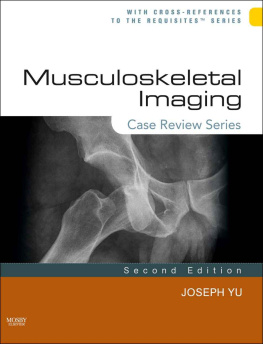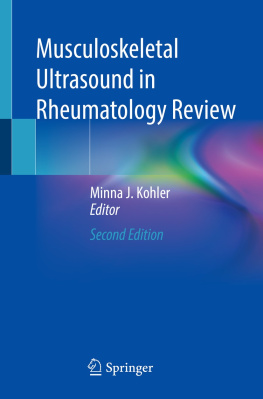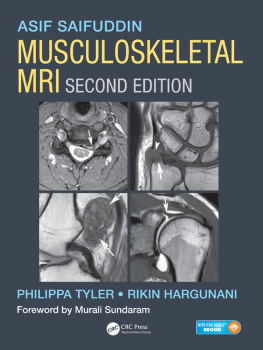Jull Gwendolen - Grieves Modern Musculoskeletal Physiotherapy E-Book
Here you can read online Jull Gwendolen - Grieves Modern Musculoskeletal Physiotherapy E-Book full text of the book (entire story) in english for free. Download pdf and epub, get meaning, cover and reviews about this ebook. year: 2016, publisher: Elsevier Health Sciences, genre: Romance novel. Description of the work, (preface) as well as reviews are available. Best literature library LitArk.com created for fans of good reading and offers a wide selection of genres:
Romance novel
Science fiction
Adventure
Detective
Science
History
Home and family
Prose
Art
Politics
Computer
Non-fiction
Religion
Business
Children
Humor
Choose a favorite category and find really read worthwhile books. Enjoy immersion in the world of imagination, feel the emotions of the characters or learn something new for yourself, make an fascinating discovery.

- Book:Grieves Modern Musculoskeletal Physiotherapy E-Book
- Author:
- Publisher:Elsevier Health Sciences
- Genre:
- Year:2016
- Rating:4 / 5
- Favourites:Add to favourites
- Your mark:
- 80
- 1
- 2
- 3
- 4
- 5
Grieves Modern Musculoskeletal Physiotherapy E-Book: summary, description and annotation
We offer to read an annotation, description, summary or preface (depends on what the author of the book "Grieves Modern Musculoskeletal Physiotherapy E-Book" wrote himself). If you haven't found the necessary information about the book — write in the comments, we will try to find it.
Grieves Modern Musculoskeletal Physiotherapy E-Book — read online for free the complete book (whole text) full work
Below is the text of the book, divided by pages. System saving the place of the last page read, allows you to conveniently read the book "Grieves Modern Musculoskeletal Physiotherapy E-Book" online for free, without having to search again every time where you left off. Put a bookmark, and you can go to the page where you finished reading at any time.
Font size:
Interval:
Bookmark:
- Tables in Chapter 7
- Tables in Chapter 8
- Tables in Chapter 10
- Tables in Chapter 11
- Tables in Chapter 12
- Tables in Chapter 14
- Tables in Chapter 15
- Tables in Chapter 20
- Tables in Chapter 21
- Tables in Chapter 22
- Tables in Chapter 25
- Tables in Chapter 26
- Tables in Chapter 27
- Tables in Chapter 32
- Tables in Chapter 35
- Tables in Chapter 37
- Tables in Chapter 39
- Tables in Chapter 42
- Tables in Chapter 43
- Tables in Chapter 44
- Tables in Chapter 45
- Tables in Chapter 46
- Tables in Chapter 47
- Tables in Chapter 48
- Tables in Chapter 49
- Tables in Chapter 50
- Tables in Chapter 51
- Figures in Chapter 2
- Figures in Chapter 3
- Figures in Chapter 4
- Figures in Chapter 5
- Figures in Chapter 6
- Figures in Chapter 7
- Figures in Chapter 8
- Figures in Chapter 9
- Figures in Chapter 10
- Figures in Chapter 11
- Figures in Chapter 12
- Figures in Chapter 13
- Figures in Chapter 14
- Figures in Chapter 15
- Figures in Chapter 16
- Figures in Chapter 17
- Figures in Chapter 18
- Figures in Chapter 19
- Figures in Chapter 20
- Figures in Chapter 21
- Figures in Chapter 22
- Figures in Chapter 24
- Figures in Chapter 25
- Figures in Chapter 26
- Figures in Chapter 27
- Figures in Chapter 29
- Figures in Chapter 30
- Figures in Chapter 31
- Figures in Chapter 32
- Figures in Chapter 33
- Figures in Chapter 34
- Figures in Chapter 35
- Figures in Chapter 37
- Figures in Chapter 38
- Figures in Chapter 39
- Figures in Chapter 41
- Figures in Chapter 42
- Figures in Chapter 43
- Figures in Chapter 44
- Figures in Chapter 45
- Figures in Chapter 46
- Figures in Chapter 47
- Figures in Chapter 48
- Figures in Chapter 50
- Figures in Chapter 51
- Figures in Chapter 52
There are approximately 140 international researchers and clinicians who have contributed to this multi-authored text and the editors thank them sincerely for not only their chapters, but for the years of work and experience behind their words. They are all to be congratulated on outstanding work. They are often forging new territory that translates into new or better quality assessment and management practices to the benefit of both the patients and practitioners. You are all making a significant contribution to musculoskeletal physiotherapy internationally.
Thanks are also given to the publishers Elsevier, Oxford and in particular to Rita Demetriou-Swanwick and Veronika Watkins who started the ball rolling and to Nicola Lally who rolled the ball to the finish line. Thanks are given to all Elsevier staff behind the scenes for their work in collating and copy-editing all chapters to bring this complex text to fruition.
Finally, the editors would like to acknowledge the work of Jeffrey Boyling who was the lead editor of the second and third editions of Grieve's Modern Manual Therapy . We as editors of this fourth edition are very well aware of your vision for these previous and acclaimed editions. On behalf of the readership, we thank you for your contribution and the massive amount of work and time you devoted to this important international text. Fly high in your (semi) retirement!
GJ
AM
DF
JL
CM
MS
Australia, United Kingdom, Germany 2015
Gwendolen Jull, Ann Moore, Deborah Falla, Jeremy Lewis, Christopher McCarthy, Michele Sterling
The theory and practice of musculoskeletal physiotherapy have grown and changed quite markedly in the decade following the publication of the third edition of this seminal text. This fourth edition aims to reflect this change and present some of the advances that have occurred in both the science and evidence base pertaining to the diagnosis and management of musculoskeletal disorders. The text also explores issues that will face clinicians and researchers over the next decade.
Several changes have been made in presenting this fourth edition. Firstly, there has been a name change from Grieves Modern Manual Therapy: The Vertebral Column to Grieves Modern Musculoskeletal Physiotherapy . This is to reflect the evolution in knowledge, models of diagnosis and contemporary practice. The original manipulative therapy concepts developed in the 1950s and 1960s by physiotherapists such as Geoffrey Maitland and Freddy Kaltenborn were presented essentially, as complete systems of assessment and management of musculoskeletal disorders. Painful musculoskeletal disorders were regarded broadly as manifestations of abnormal movement and articular dysfunction. Such concepts set physiotherapists on a path of detailed analysis of the symptoms and signs of a patient's musculoskeletal disorder, which were interpreted on predominantly kinesiological, biomechanical and neurophysiological bases, taking the individual patient into account. It was recognized even then that the patho-anatomical model was not very helpful in designing manipulative therapy management programmes. Health professionals were first challenged about the inadequacy and limitations of regarding illness only on a biological basis by Engel in 1977, presented for consideration a new clinical model for the treatment of low back pain which embraced the biopsychosocial principles. It spurred a massive volume of research internationally to understand psychological and social moderators and mediators not only of back pain, but of all chronic musculoskeletal disorders. There has also been a surge of research into the neurosciences pertaining to, for example, pain, movement and sensorimotor function in musculoskeletal disorders. The knowledge gained through this research has had and is having a profound influence on physiotherapists' approaches to the diagnosis and management of musculoskeletal disorders. The original concepts of manipulative therapy have grown to embrace new research-generated knowledge. There have been expansions in practice to embrace the evidence for, for example, the superiority of multimodal management approaches which include consideration of and attention to psychological or social moderators. The original manual therapy or manipulative therapy approaches have metamorphosed into musculoskeletal physiotherapy and this is recognized by the change in title of this text.
A second change is the expansion of the focus of the text from the vertebral column to the entire musculoskeletal system. In this edition, both the spine and extremities are considered for the first time. This was a logical progression of the scope of the text as the relevance of much of the basic, behavioural and clinical sciences and indeed the principles of practice are not confined to one body region. There can certainly be peculiarities in the nature of the disorders and their management in the various regions of the body and this has been respected, particularly in the section which overviews contemporary issues in practice (Part IV).
The third change is in the nature of the content of the text. The aims in assembling this multi-authored text were to capture some of the advances in the science and practices made in the last decade relevant to musculoskeletal physiotherapy, to look futuristically at emerging areas as well as presenting some of the current issues in practice. Initially, emphasis is placed on the advances in the sciences underpinning musculoskeletal physiotherapy practice, where there is commentary on topics such as pain, movement, motor control, the interaction between pain and motor control as well as neuromuscular adaptations to exercise. There is also consideration of applied anatomical structure as well as the current and future field of genetics in musculoskeletal pain. A new section of the text highlights the important area of measurement and presents the scope of current and emerging measurements for investigating central and peripheral aspects relating to pain, function and morphological change. It is important for clinicians to be intelligent and discriminating consumers of research. A section of the text has therefore been devoted to discussing some contemporary research approaches including quantitative and qualitative methods to gather, test and examine treatment effects in their broadest interpretation. Importantly, translational research is discussed, the process which ensures that evidence-based practices which are developed in the research environment genuinely make change in clinical practice and policy/procedures.
Font size:
Interval:
Bookmark:
Similar books «Grieves Modern Musculoskeletal Physiotherapy E-Book»
Look at similar books to Grieves Modern Musculoskeletal Physiotherapy E-Book. We have selected literature similar in name and meaning in the hope of providing readers with more options to find new, interesting, not yet read works.
Discussion, reviews of the book Grieves Modern Musculoskeletal Physiotherapy E-Book and just readers' own opinions. Leave your comments, write what you think about the work, its meaning or the main characters. Specify what exactly you liked and what you didn't like, and why you think so.







